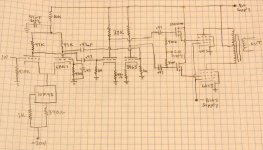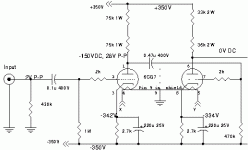I've been looking at cathode follower based output stages and thus trying to figure out a way to generate the large driving voltage required. I saw something on John Broskie's TubeCad website that had some sort of arrangement with 6SN7-esque triodes in series to generate large swings, and counteract the max plate voltages of the tubes. I've been trying to find this but many google searches have turned up nothing!
What ways are there to generate such swings, say on the order of 400v p-p or more, without transformer or inductor loading?
What ways are there to generate such swings, say on the order of 400v p-p or more, without transformer or inductor loading?
In order to get 400V p-p with a resistive or active load, the rule of thumb for triodes is to have a minimum 600V supply. Triodes swing about 2/3 B+. You also need a tube rated for an absolute minimum of 300V plate. The 6SN7 rated for 450V is a good choice, as well as some of the TV tubes have voltage ratings up to 550 V plate.What ways are there to generate such swings, say on the order of 400v p-p or more, without transformer or inductor loading?
HTH
Doug
The max plate voltage is the maximum DC voltage The tube can tolerate twice this voltage as AC.With regards to max plate voltage, can this be briefly exceeded under transient conditions ie signal peaks?
I was thinking about that tube when I replied. However, I know there are different but comparable tubes across the pond.What about something like the 6S4A
DougL said:
I was thinking about that tube when I replied. However, I know there are different but comparable tubes across the pond.
ooh? pray tell what those might be
I would suggest a bit of bootstrapped positive feedback, similar to what is done in the McIntosh driver stage. It's a good simple way to achieve large voltage swing, without having very high B+ voltage. Pentodes might be a better choice than triodes, as they can swing a large voltage more easily.
bigwill said:What ways are there to generate such swings, say on the order of 400v p-p or more, without transformer or inductor loading?
CCS loading. I had the same problem with an 845 design. That requires a swing of 310Vp-p to get it to max power. Here's a loadline. 6BX7 CC Loadline
Of course, without xfmrs or inductors, you will also need lotsavolts as well. In this case, I used a 6BX7 -- a vertical deflection type that can handle that. It operates off a +/- 410Vdc supply.
luvdunhill said:
ooh? pray tell what those might bewhat about 3D21A?
hey-Hey!!!,
Lots ov the TV sweep pentodes will do the job. It'll still need lots ov B+, and lower plate loads need higher dissipation tolerance at the anode. These will work with low g2 voltage too. 6AV5GA, 6CB5A, 6CD6....I've even used some of these in linestage gain-stages running itsy-bitsy plate loads( ~500R ).
cheers,
Douglas
I've been looking at cathode follower based output stages and thus trying to figure out a way to generate the large driving voltage required.
I have spent some time playing with cathode follower output stages at power levels from 5 to 30 watts. Much larger ones are planned but much of my experimentation has been on hold lately. Many of my (and other peoples) experiments (with schematics) can be found in the following two threads:
http://www.diyaudio.com/forums/showthread.php?s=&threadid=105859&highlight=
http://www.diyaudio.com/forums/showthread.php?s=&threadid=114021&highlight=
As stated previously to get a large voltage swing without iron you need a large supply voltage and a tube that can handle the voltage. A CCS load helps and you need to use a tube that saturates st a low voltage (the voltage drop across a fully turned on tube). Tubes that fit all these requirements are TV sweep tubes. There are several limiting factors that determine the voltage handling capability of a tube. Sometimes it is an issue with flashover or arc breakdown but often there is a voltage where the grid can no longer control the plate current and the tube will go into a runaway condition. This can be due to the individual tubes construction and the quality of its vacuum. Therefore it is possible to severely exceed the ratings on one tube while another tube with the same number will not take much beyond the published ratings.
As stated before the published ratings are for the maximum DC plate voltage. This can (and will) go to at least twice this under normal operation and can often go higher than this if an inductive load is used. I have seen 1200 volt peaks on the plate of a 6L6GC under normal operation in a guitar amp, and 2000 volt peaks with a mismatched load under severe clipping. I also know that the usual failure mode for a overvoltaged 6L6GC is an arc from pin 3 (plate) to pin 2 (filament) on the outside of the tube, either inside the base or on the socket itself. This can lead to destruction of the OPT or the power transformer.
Back to the CF output stages. The 6EM7 driver stage shown in my schematics can easilly put out 450V p-p. A 6SL7 or 12AT7 could be used for the first stage and a 6S4 or 12B4 can be used for the second stage. The first stage could be a LTP with 2 seperate second stages. I have done something like this for a screen driven P-P amp. The schematic is included.
The augmented cathode follower is also another possibility. It looks complicated, and it is, but it has advantages. Both cathode followers operate with a constant voltage across them for far lower distortion and the circuit can be set up to have gain, lowering the drive requirements.
Attachments
- Status
- This old topic is closed. If you want to reopen this topic, contact a moderator using the "Report Post" button.
- Home
- Amplifiers
- Tubes / Valves
- Generating big voltage swings without 'iron'

